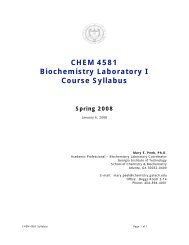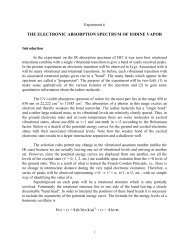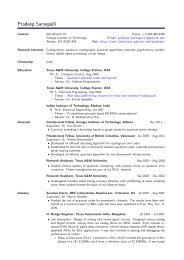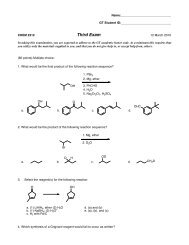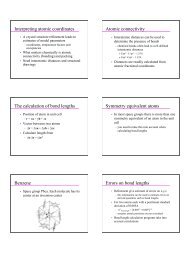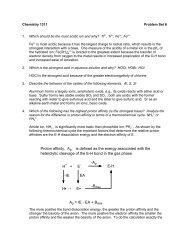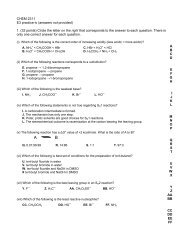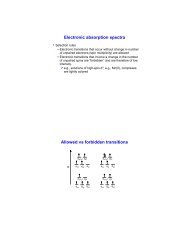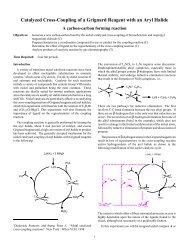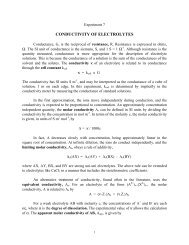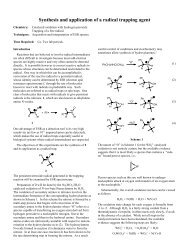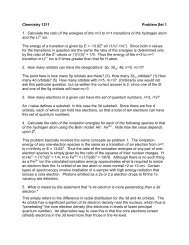Crystals and crystal growth
Crystals and crystal growth
Crystals and crystal growth
You also want an ePaper? Increase the reach of your titles
YUMPU automatically turns print PDFs into web optimized ePapers that Google loves.
Internal structure <strong>and</strong> unit cellsMicrographs of virus <strong>crystal</strong>s <strong>Crystals</strong> consist of ordered arrays of objects(molecules, ions .....) The description of <strong>crystal</strong> structures can besimplified using the translational symmetryof the solid <strong>and</strong> breaking it up intotranslationally equivalent unit cellsDefects in <strong>crystal</strong>s Real <strong>crystal</strong>s never contain perfectlyordered arrays of atoms - there are alwaysdefectsThe unit cell Always use a right h<strong>and</strong>ed axis systemThe seven <strong>crystal</strong> systemsCrystal system Unit cellUnit cell Lattice symmetryedge lenghs anglesTriclinic a ° b ° c ° ° ° 90 o -12/mMonoclinic a ° b ° c = = 90 o > 90 oOrthorhombic a ° b ° c = = = 90 o mmmTetragonal a = b ° c = = = 90 o 4/mmmTrigonalrhombohedral latticea = b = c = = ° 90 o -3mHexagonal a = b ° c = = 90 o6/mmm = 120 oCubic a = b = c = = = 90 o m3mCrystal <strong>growth</strong> -theory Initially form a nucleus– this is highly dependent upon the presence ofimpurities <strong>and</strong> vessel surfaces Growth of nucleus– <strong>growth</strong> depends upon the presence of lowenergy surface sites such as steps– low energy faces grow fastest– presence of additives in solution may alterrelative rates for different faces
Crystal <strong>growth</strong> - practice Many techniques are available– choice of method depends upon the material Grow from molten solid Grow from solution– this can include solvents as diverse as water <strong>and</strong>molten PbO! Grow from vapor phaseGrowth from the melt Very important, but not possible for mostmaterials Material must be stable above melting point Phase diagram must allow direct<strong>crystal</strong>lizationLi 2 O - Nb 2 O 5 phase diagramGrowth from the vapor phase Not very common Used for some sublimable compounds Used where a material can be transported bythe addition of an appropriate reagent–ZnS (s) + I 2(g) --- ZnI 2(g) + 1/8S 8(g) (exothermic)Growth from solutionVapor <strong>and</strong> solute diffusion The most common method Based on precipitation from a saturatedsolution Saturation can be achieved in many ways– cool solution– evaporate solvent off– add things to solvent to reduce solubility
Crystal habit The habit of a <strong>crystal</strong> is its external shapeMeasurement of interfacial angles The angles between the external faces of a<strong>crystal</strong> are characteristic of the material Measured using a goniometer External faces are the slowest growing faces Habit depends upon <strong>growth</strong> conditionsDescribing <strong>crystal</strong> facesMiller Indices Crystal faces can be assigned labels calledMiller Indices– derived from how the face cuts the cell axesStereographic projectionsDifferent habits for cubic <strong>crystal</strong>s
Translational symmetryThe lattice Real <strong>crystal</strong>s consist of repeating patterns ofmolecules or ions or clusters ... It is often convenient to separate therepeating pattern from the object that isbeing repeated




